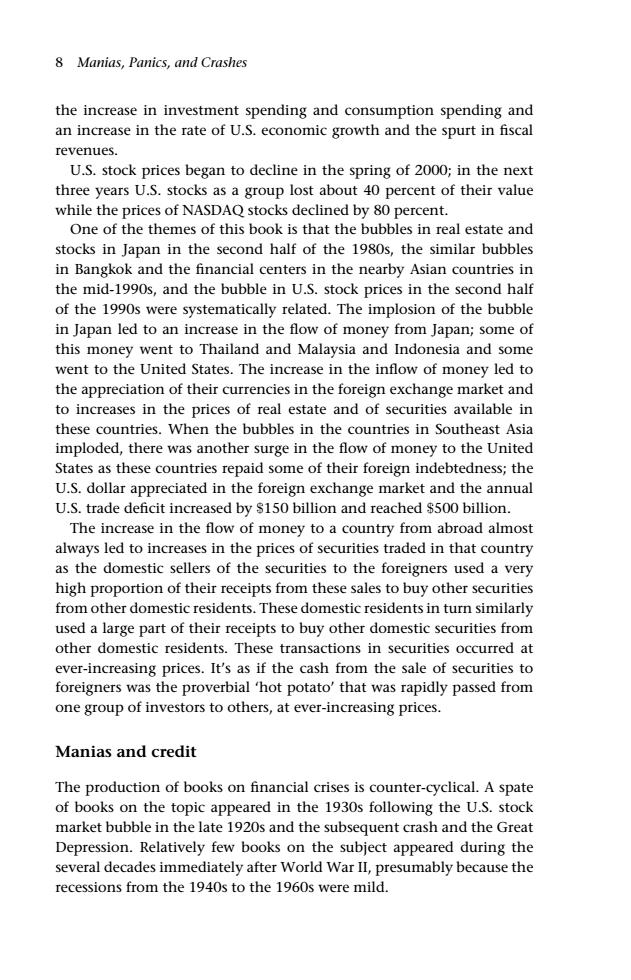正在加载图片...

8 Manias,Panics,and Crashes the increase in investment spending and consumption spending and an increase in the rate of U.S.economic growth and the spurt in fiscal revenues. U.S.stock prices began to decline in the spring of 2000;in the next three years U.S.stocks as a group lost about 40 percent of their value while the prices of NASDAQ stocks declined by 80 percent. One of the themes of this book is that the bubbles in real estate and stocks in Japan in the second half of the 1980s,the similar bubbles in Bangkok and the financial centers in the nearby Asian countries in the mid-1990s,and the bubble in U.S.stock prices in the second half of the 1990s were systematically related.The implosion of the bubble in Japan led to an increase in the flow of money from Japan;some of this money went to Thailand and Malaysia and Indonesia and some went to the United States.The increase in the inflow of money led to the appreciation of their currencies in the foreign exchange market and to increases in the prices of real estate and of securities available in these countries.When the bubbles in the countries in southeast asia imploded,there was another surge in the flow of money to the United States as these countries repaid some of their foreign indebtedness:the U.S.dollar appreciated in the foreign exchange market and the annual U.S.trade deficit increased by $150 billion and reached $500 billion The increase in the flow of money to a country from abroad almost always led to increases in the prices of securities traded in that country as the domestic sellers of the securities to the foreigners used a very high proportion of their receipts from these sales to buy other securities from other domestic residents.These domestic residents in turn similarly used a large part of their receipts to buy other domestic securities from other domestic residents.These transactions in securities occurred at ever-increasing prices.It's as if the cash from the sale of securities to foreigners was the proverbial 'hot potato'that was rapidly passed from one group of investors to others,at ever-increasing prices Manias and credit The production of books on financial crises is counter-cyclical.A spate of books on the topic appeared in the 1930s following the U.S.stock market bubble in the late 1920s and the subsequent crash and the Great Depression.Relatively few books on the subject appeared during the several decades immediately after World War II,presumably because the recessions from the 1940s to the 1960s were mild. c01 JWBK120/Kindleberger February 13, 2008 14:58 Char Count= 8 Manias, Panics, and Crashes the increase in investment spending and consumption spending and an increase in the rate of U.S. economic growth and the spurt in fiscal revenues. U.S. stock prices began to decline in the spring of 2000; in the next three years U.S. stocks as a group lost about 40 percent of their value while the prices of NASDAQ stocks declined by 80 percent. One of the themes of this book is that the bubbles in real estate and stocks in Japan in the second half of the 1980s, the similar bubbles in Bangkok and the financial centers in the nearby Asian countries in the mid-1990s, and the bubble in U.S. stock prices in the second half of the 1990s were systematically related. The implosion of the bubble in Japan led to an increase in the flow of money from Japan; some of this money went to Thailand and Malaysia and Indonesia and some went to the United States. The increase in the inflow of money led to the appreciation of their currencies in the foreign exchange market and to increases in the prices of real estate and of securities available in these countries. When the bubbles in the countries in Southeast Asia imploded, there was another surge in the flow of money to the United States as these countries repaid some of their foreign indebtedness; the U.S. dollar appreciated in the foreign exchange market and the annual U.S. trade deficit increased by $150 billion and reached $500 billion. The increase in the flow of money to a country from abroad almost always led to increases in the prices of securities traded in that country as the domestic sellers of the securities to the foreigners used a very high proportion of their receipts from these sales to buy other securities from other domestic residents. These domestic residents in turn similarly used a large part of their receipts to buy other domestic securities from other domestic residents. These transactions in securities occurred at ever-increasing prices. It’s as if the cash from the sale of securities to foreigners was the proverbial ‘hot potato’ that was rapidly passed from one group of investors to others, at ever-increasing prices. Manias and credit The production of books on financial crises is counter-cyclical. A spate of books on the topic appeared in the 1930s following the U.S. stock market bubble in the late 1920s and the subsequent crash and the Great Depression. Relatively few books on the subject appeared during the several decades immediately after World War II, presumably because the recessions from the 1940s to the 1960s were mild